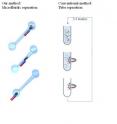New technology for bioseparation
Separating target molecules in biological samples is a critical part of diagnosing and detecting diseases. Usually the target and probe molecules are mixed and then separated in batch processes that require multiple pipetting, tube washing and extraction steps that can affect accuracy. Now a team of researchers at Brown University has developed a simple new technique that is capable of separating tiny amounts of the target molecules from mixed solutions by single motion of magnet under a microchannel. Their technique may make pipettes and test tubes a thing of the past in some diagnostic applications and increase the accuracy and sensitivity of disease detection.
The new platform developed by Anubhav Tripathi and his team at Brown doesn't rely on external pumps to mix samples or flow target molecules. Instead, their system is static and handy for researchers to use, according to Ms. Jingjing Wang, a graduate student pursuing her PhD. Bead-like magnetic particles are specifically modified by attaching short pieces of DNA to them that can capture target DNA molecules with specific sequences matching. Those are then separated for detection simply by pulling the magnetic beads along the channel. The process is simple, fast and specific.
This process has great applicability particularly for point-of-care platforms that are used to detect bacterial, viral infections and prion diseases by DNA, RNA or protein identification. Specific disease applications include testing for HIV and influenza, explained Wang.
"It can also be used to evaluate the expression of certain protein markers, such as troponin (an indicator of damage to the heart muscle) or any detection that requires binding and separation of known target biomolecules," she added.
Optimizing the system and characterizing the chip for biological assays was the biggest challenge for the research team as it required that both engineering as well as biological factors be considered, however the team is already developing assays using this new platform. A new microchip based Simple Method of Amplifying RNA Targets (SMART) assay developed to detect influenza from patient samples is already showing high agreement with Polymerase Chain Reaction (PCR), which is considered the "gold standard" for influenza diagnosis. The team's next challenge is developing assays using this technique to detect wild type and drug-resistant HIV in areas with limited resources such as Kenya and South Africa.
Source: American Institute of Physics (AIP)
Other sources
- New technology for bioseparationfrom Science DailyTue, 17 Sep 2013, 17:30:25 UTC
- New Technology for Bioseparationfrom Newswise - ScinewsTue, 17 Sep 2013, 16:31:33 UTC
- New technology for bioseparationfrom PhysorgTue, 17 Sep 2013, 15:30:46 UTC
